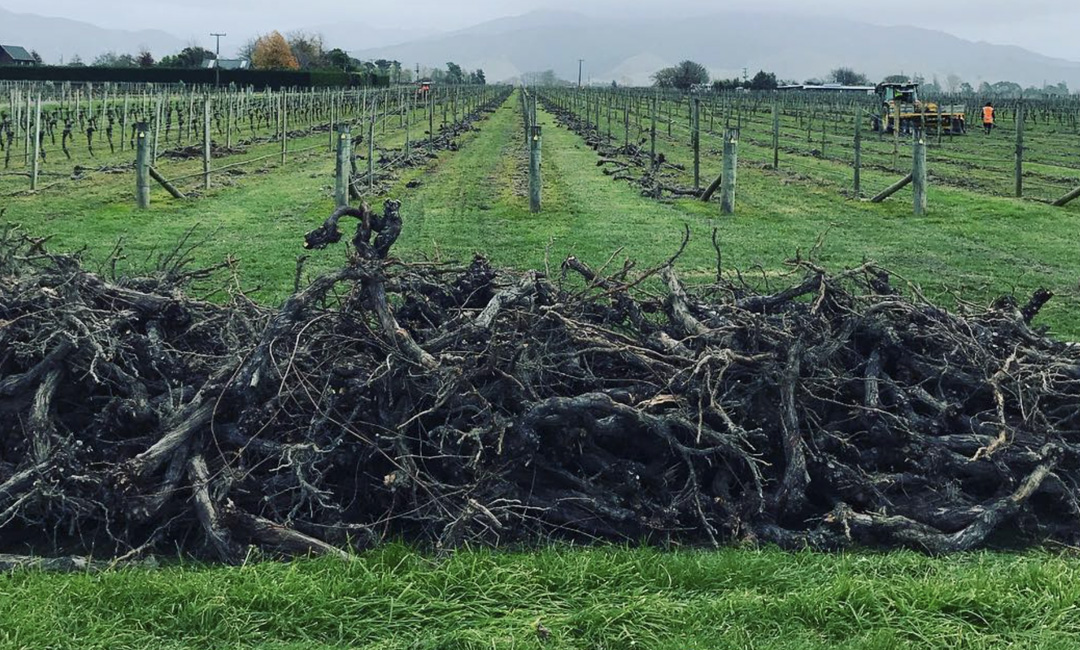Soil Preparation for Vineyard Redevelopments
Many Marlborough vineyards are now looking at a redevelopment programme, either to replace existing vineyard with a high level of trunk disease, change varieties (usually from something else to Sauvignon Blanc) or else to reduce row spacing or increase vine density to increase yield per hectare.

Soil Preparation for Vineyard Redevelopments | What’s the issue?
Article kindly supplied by Mike Insley - Viticultural & Wine Production Consultant
www.grapesense.co.nz

Many Marlborough vineyards are now looking at a redevelopment programme, either to replace existing vineyard with a high level of trunk disease, change varieties (usually from something else to Sauvignon Blanc) or else to reduce row spacing / increase vine density to increase yield per hectare.
Replanting the same crop species on the same site can result in poor growth and even plant death through a condition termed “replant disease or “replant disorder” (also referred to as “tired soil”, “soil decline” or “soil sickness”). The phenomenon is well known for many fruit crops, especially apples and stonefruit. It has also been noted with grapevines.
The cause of the disease is usually put down to a build-up of pathogenic fungi and other microorganisms in the soil, through both constant cropping with a single species over a long period of time and also due to the potentially large amount of decaying root and wood material left behind after vine removal. Poor nutrient status may also be involved, especially as the young vine roots will be trying to exploit the shallower soil levels which may have supported previous vines for up to 50 years for the oldest vineyards in Marlborough.
Organisms implicated with replant disease and known to cause issues for grapevines include Pythium, Fusarium, Ilyonectria (and other Cylindrocarpon-like fungi associated with Black Foot disease), Rhizoctonia and Pseudomonas. Research and field studies have shown that grapevine fungal pathogens such as Pythium and Botrysphaeria (also part of the trunk disease complex) can infect through soil and root transmission. It makes sense to reduce the presence of these fungi where possible, to give the young, newly planted vines the best possible start.
What to do - Three key points:
1. Remove as much vine and root material prior to planting as possible.
- Root raking, pick up and removal.
- The soil is always better if it can be cultivated and aerated somehow before replanting. Cultivation will also encourage rapid decomposition of old vine material (noting the potential negative effects cultivation can have on soil structure and organic matter levels, more on that later).
- Burn or remove old vines and root material off site.
2. If possible, move rows over so the new vine is not being planted in the same planting line as previous vines.
- Not always possible if a “vine out, vine in” strategy is being followed but should be standard practice if a full redevelopment of trellis, irrigation etc is being implemented.
- If carrying out a full redevelopment, consider a fallow year with a biofumigant crop to allow more breakdown of remaining grapevine material.
3. Sow biofumigant and soil builder cover crops before, during and after replanting.
- Brassica crops (eg Mustards) in particular are known to have biofumigant activity,releasing glusosinalate compounds as they breakdown in soil. These compounds are further metabolised to provide useful soil fumigant activity, suppressing plant pathogens. Brassicas are best worked in to achieve this effect. Ideally Autumn sown although they can be Spring sown as well.
- Following a biofumigant and at the completion of redevelopment activity (vines are at the wire and being pruned for their first crop), sow a brassica / legume / cereal / flower mix and leave in place to set seed before crimp rolling. This will start to rebuild soil organic matter and structure which may have been impacted through the redevelopment phase. Sowing every second row allows for good access for both hand and machinery work.
Potential Seed Mixes
(Information courtesy of Kiwi Seeds)
Brassica Biofumigant
Mustards have the best biofumigant activity however other brassicas can also be used. Using several different mustard varieties and other brassicas may result in a better “stand”. The cover crop can be rolled however working it in will likely give a better biofumigant activity.
A combination brassica biofumigant seed mix is given below:

Soil Builder Mix
Cultivation can damage soil structure and reduce soil organic matter. Sowing a high biomass cover crop in every second row and leaving it in place for 2 years or so can help to remediate this. Allow the cover crop to set seed and dry before crimp rolling.

Notes: 1. The Replant Disease Syndrome
After replanting similar crop species at the same site, severe plant growth depression can be observed. This phenomenon has been termed as “replant problems” (then including soil structural and chemical problems [1]), “soil sickness”, “soil decline”, “soil fatigue”, or “replant disease”. Since partial or full soil disinfection can restore plant growth in most cases, biological living agents are the most likely cause of replant problems. According to Winkelmann et al. [2], replant disease is “the harmfully disturbed physiological and morphological reaction of plants to soils that faced alterations in their (micro-) biome due to the previous cultures of the same or related species.” This definition implies the previous culture as the starting point of replant disease, which affects the soil microbial and mesofauna communities by root exudates or rhizodeposits and decomposition of plant parts. Thus, replant disease can be classified as negative plant-soil feedback [3] and is mainly due to microbial dysbiosis [2]. Replant disease has been reported for many horticultural and forestry crops, being especially pronounced in fruit orchards with apple [2,4], peach [5,6] and cherry [7,8], but also affecting roses [9,10], grapevine [11,12], asparagus [13], medicinal plants like Rehmannia glutinosa [14], and several forestry tree species [15].